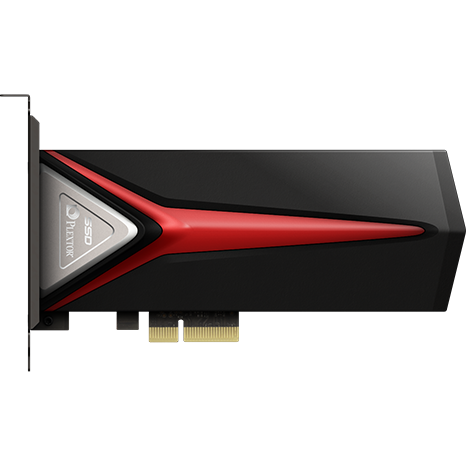Early Verdict
The Plextor M8Pe 512GB offers a great user experience at an affordable price. It's not the lowest priced NVMe SSD, but it scores high in usability, options, and features. We would like to see Plextor add support for the advanced software, but we'll have to wait for that update. In the meantime, the M8Pe 512GB is stand on solid ground with its strong performance.
Pros
- +
Full 512GB capacity
- +
Exceptional application performance
- +
High endurance
- +
MLC NAND
- +
Two heatsink options
Cons
- -
Plextor software tools missing (at the time of writing)
- -
Transfer performance
- -
Erratic pricing
- -
Heatsink recommended
Why you can trust Tom's Hardware
Specifications & Features
UPDATE: This review was updated to include the 512GB capacity of this drive series.
Plextor went crazy with the new M8Pe NVMe series; it offers three different models of the same SSD to give you several form factor and cooling options. Each model ships in four different capacities. We just received the new M8Pe firmware for our three 1TB samples and will isolate each product with performance benchmarks to help you decide which is best in each class.
Plextor uses the same underlying technology for all three models. Plextor is the first enthusiast-focused company to use the Marvell Eldora controller in a consumer application. The controller has impressed us at trade shows, and we've seen it pushing as much as 3,500 MB/s in a well-cooled and overclocked configuration. Plextor offers up a heaping plate of performance, but it didn't push the performance envelope to the limit even though its add-in card form factor offers the best cooling solution for any factory M.2-based SSD we've ever tested.



Plextor also offers two M.2 2280 options. The first uses a sliver of a heatsink to reduce thermal throttling, but it may fit in some notebooks. The third and final option ships without a heatsink, which is guaranteed to work in your notebook--with one possible exception. One capacity, the double-sided 1TB drive, features components on both sides of the printed circuit board. Double-sided M.2 2280 SSDs fit in many notebooks, but there are rare exceptions. We can't speak about how the notebook market will tackle this issue in the future, but the height difference between single-sided and double-sided M.2 sockets is a little over 1 millimeter. It wouldn't make a lot of sense for notebook makers to disqualify a large number of exciting, high-capacity products just to shave a millimeter from the Z-height.
In typical Plextor fashion, the M8Pe features some shenanigans. The company dedicated its resources to build its impressive Plextool software suite over the last several years, and you can’t find many of its features on Samsung's Magician, Intel's SSD Toolbox or OCZ's SSD Guru. Plextool and the accompanying software packages are truly unique. Users can hide active folders with hotkeys, use a complex but automatic compression algorithm and enable an SLC cache tier, among many other features. Sadly, none of that works with the M8Pe. If I ever wanted to use a frown face in a review, this would be the time.
Software aside, the Plextor M8Pe is a strong NVMe SSD contender for enthusiast users. The MLC flash ensures a long device lifespan and the SSD offers Plextor’s best performance yet.
Technical Specification
Plextor selected the Marvell 88SS1093 Eldora 8-channel NVMe controller with third-generation NANDEdge low-density parity check (LDPC) error correction and management technology. Marvell built the tri-core controller on a 28nm CMOS process to reduce heat generation and power consumption during heavy workloads.
Get Tom's Hardware's best news and in-depth reviews, straight to your inbox.
There are three distinct models in the M8Pe series. The M8Pe(Y) uses an M.2 2280 SSD encased in an add-in card adapter with a hefty heatsink that keeps the controller and one side of the board cool. The M8Pe(G) is an M.2 2280 SSD with a thin aluminum heatsink coupled to one side of the printed circuit board with double-sided tape that acts as a thermal transfer material. Lastly, the M8PeGN is the bare M.2 2280 SSD without a heatsink.
We didn't have a problem running the M8Pe(G) in our Lenovo Y700-17 notebook with the heatsink installed. We caution that the drive may not fit in all notebooks. Also, if you do separate the SSD from the heatsink, it will not stick together again. We removed the heatsink after testing and destroyed the thermal transfer material. It is possible to find new thermal transfer material, but you will need to find a pad that has a strong double-sided adhesive to secure the heatsink.
There are four capacities in this series that range from 128GB to 1TB. All of the models use a single-sided design except for the large 1TB model.
The M8Pe is a high-performance product that delivers up to 2,500 MB/s sequential read and up to 1,400 MB/s sequential write. Plextor didn't rely on the “normal” NVMe tricks that some vendors use to achieve these numbers, such as using complex and unrealistic multi-threaded workloads. End users can reproduce the results with simple one-click test tools. This article focuses on the largest model. We are waiting for a firmware update to test the 512GB model.
Plextor doesn't hide thermal throttle conditions from users. The M8Pe is the company's first NVMe SSD, and it uses one of the first retail-destined Marvell NVMe controllers. Marvell’s previous NVMe controllers were all purpose-built system integrator models. Point being, retail NVMe is new territory for both companies. Plextor is forthcoming and shows both read and write thermal throttle conditions and performance on the product page, and includes metrics both with and without the M8Pe(Y) heatsink.
Users can read sequential data nonstop for 70 seconds at 2,400 MB/s before encountering a throttle condition. This equates to a 168GB data transfer. You can also write sequential data nonstop for 40 seconds at 1,300 MB/s, or 52 gigabytes. My theory is that the largest single file transfer most users will move at one time is a Blu-Ray ISO, which is 40 to 50 gigabytes of data. The M8Pe’s pre-throttle performance exceeds that threshold, but only by a small margin during sequential data writes. Plextor designed the M8Pe series for gamers, so over the life of the products, you may migrate your Steam folder, which is often much larger than a movie. You may experience thermal throttle conditions during that type of rare extended workload, but we don't worry about outliers that you may experience only once a year.
Pricing & Accessories
All three M8Pe models ship with a mounting screw. The add-in card ships with a standard computer case screw with coarse threads for the PCIe slot, and it also ships with a half-height bracket. The two M.2 models ship with a fine thread screw for M.2 standoff posts.
The company offers several very good software tools for SSDs, including a DRAM cache feature, isolated/hidden folder and even an automatic compression algorithm, but the M8Pe series does not support any of Plextor's software at this time--Plextool included. This may change over time, but Plextor didn't elaborate on its plans for the future. We hope these tools receive updates to work with the new flagship series.
| Amazon Pricing | 128GB | 256GB | 512GB | 1TB |
|---|---|---|---|---|
| M8Pe(Y) AIC | $119.99 | $188.18 | $239.99 | $429.99 |
| M8Pe(G) M.2 Heatsink | $89.99 | $119.99 | $199.99 | $429.99 |
| M8PeGN M.2 Bare | $74.99 | $114.99 | $189.99 | $414.99 |
We found every model and capacity at Newegg, other than the M8Pe(Y) 256GB. Amazon lists the 256GB drive with the add-in card heatsink as well as the other models. There wasn't a price difference between Amazon and Newegg at the time of writing.
Warranty & Endurance
The Plextor M8Pe series ships with a limited five-year warranty. The limited distinction stems from the drive's TBW endurance rating, which scales with capacity and represents a rough guideline of how much data you can write to the SSD while remaining within the warranty. The 128GB model supports up to 192TB of data writes, which increases to 384TB for the 256GB and 768TB for the 512GB and 1TB models.
Product Packaging


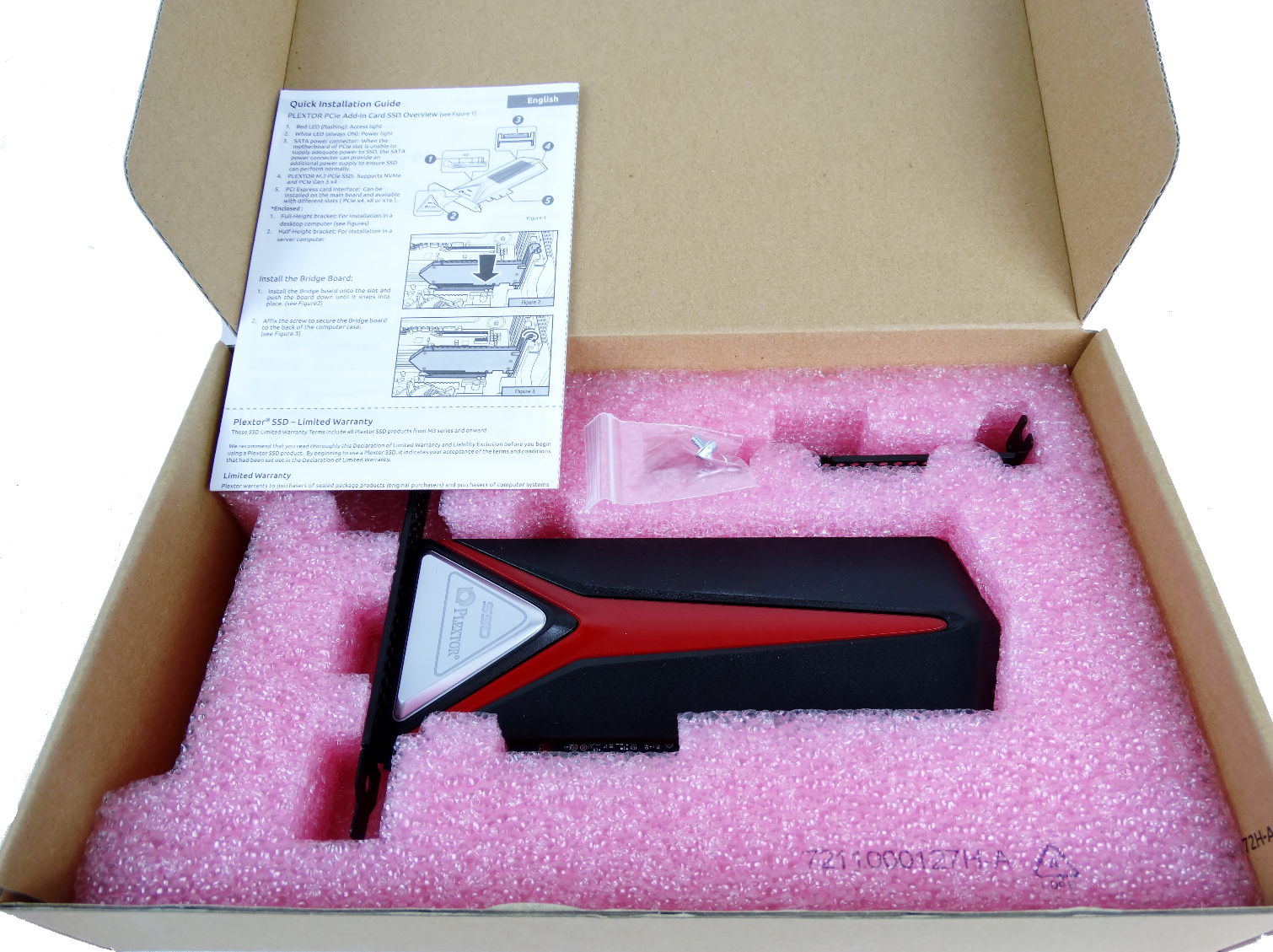
The P8Me(Y) add-in card ships in a bigger package to accommodate the large heatsink. Plextor used a foam liner to secure the SSD. The half-height bracket and computer case PCIe screw are in a separate chamber. There is an additional foam piece (not pictured) that fills in the gap on top.

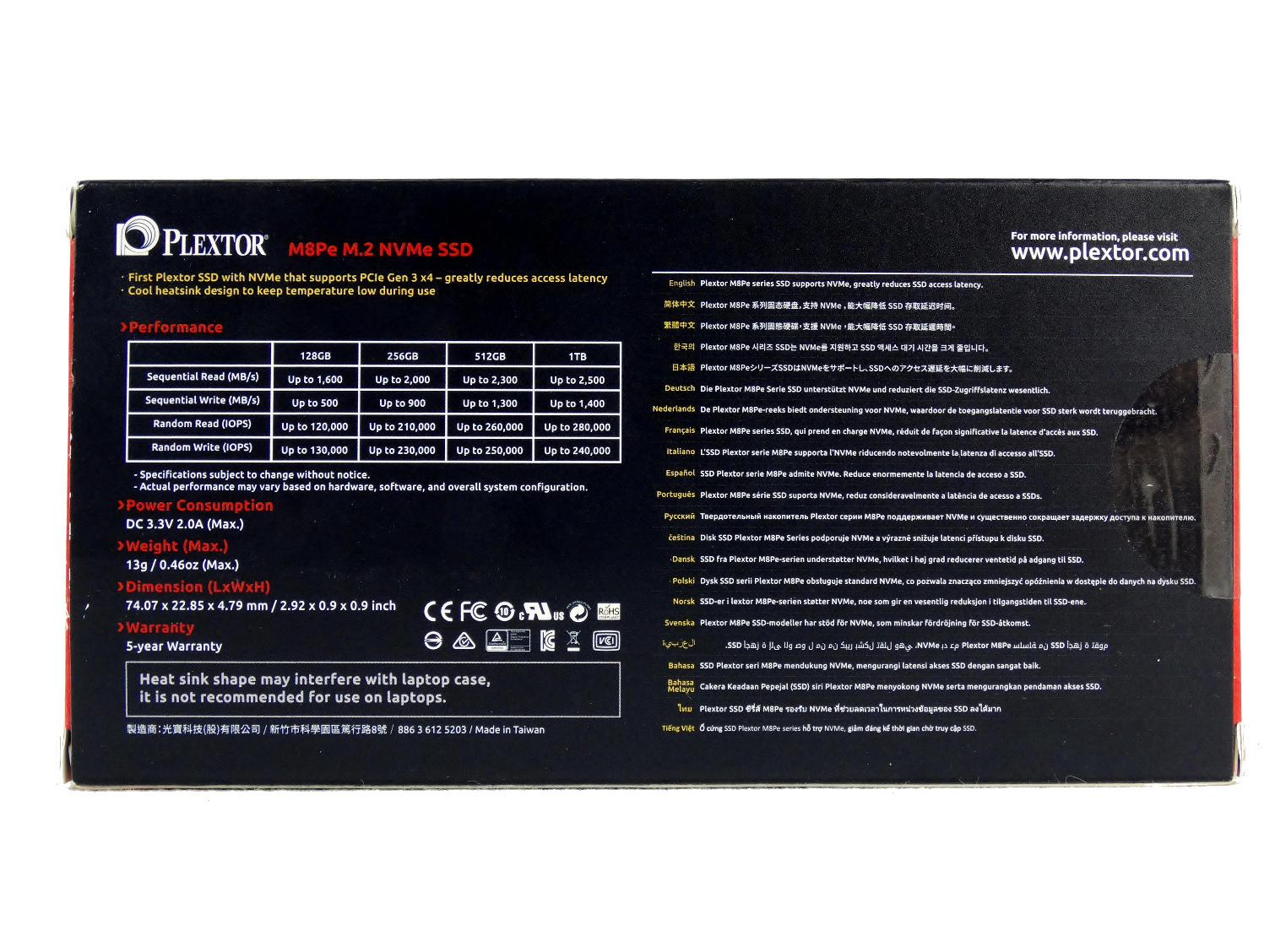
The two true M.2 2280 form factor parts ship in a simple, and much smaller, box. You will notice on the bottom left side corner that Plextor chose to be conservative and list the M8Pe(G) with the heatsink as not notebook compatible. Unofficially, I would say this is open to interpretation. The drive will fit in some, but not all, notebooks. Later in the review, we will explore the difference in performance difference between a bare M8Pe and one with an M.2 heatsink.
A Closer Look

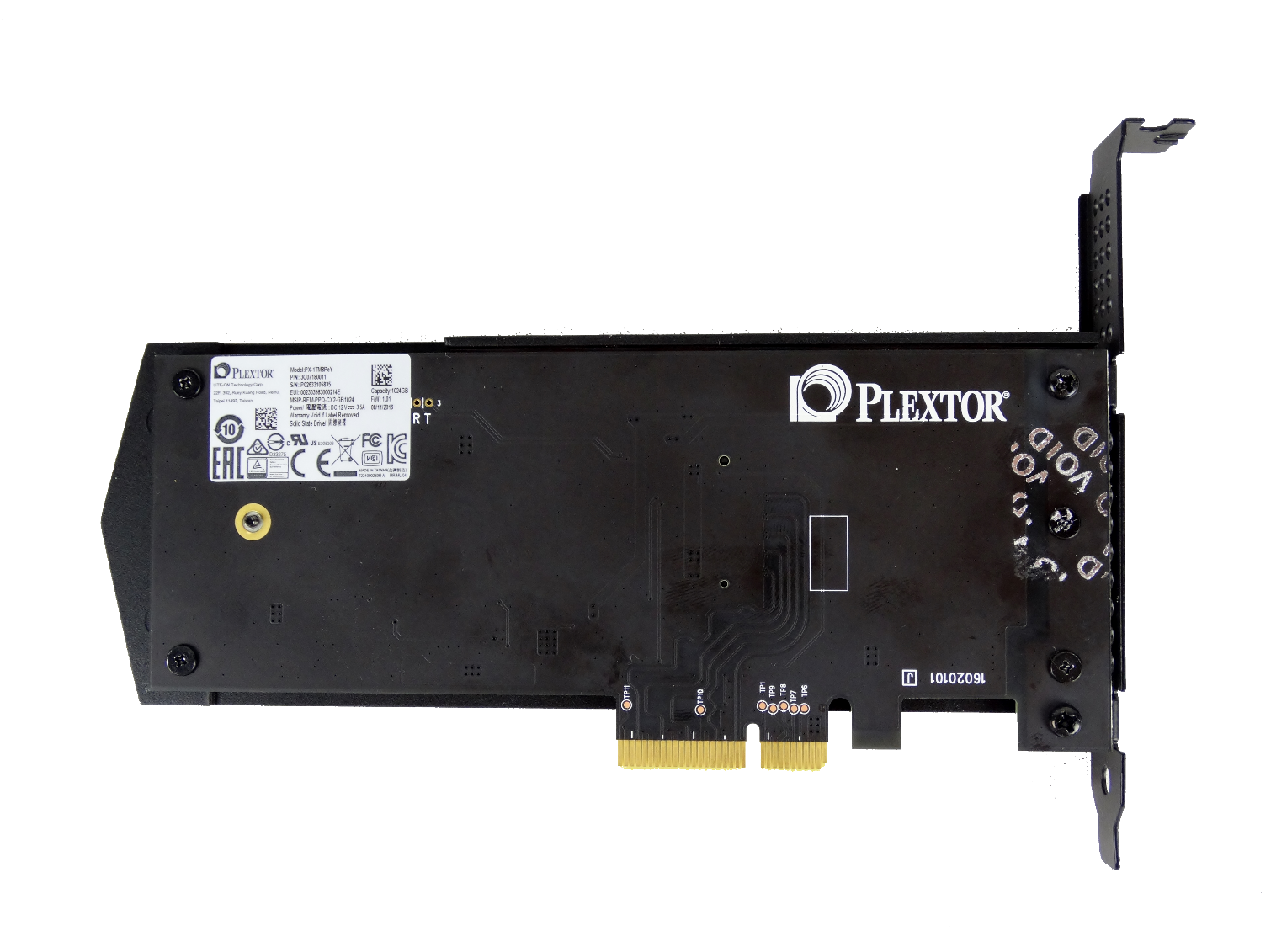






Plextor went overboard with the M8Pe(Y) heatsink, but we love total overkill. The block is a solid piece of machined sand cast aluminum with some form of paint or powder coating. This is the same process used to manufacture Ferrari and Ducati R series engine blocks. There is more than meets the “Y” with this add-in card adapter. Plextor filled the card with surface mount LEDs, and the triangle LEDs stay lit when your computer powers on. The outside edge LEDs pulse with disk activity. It is fascinating to see in a desktop system with a clear panel. Plextor also added a secondary power source via a SATA power connector. We ran a few tests with and without the supplemental power and didn't find a performance benefit. The cable running to the card did take away from the clean case look, but it isn't a requirement.



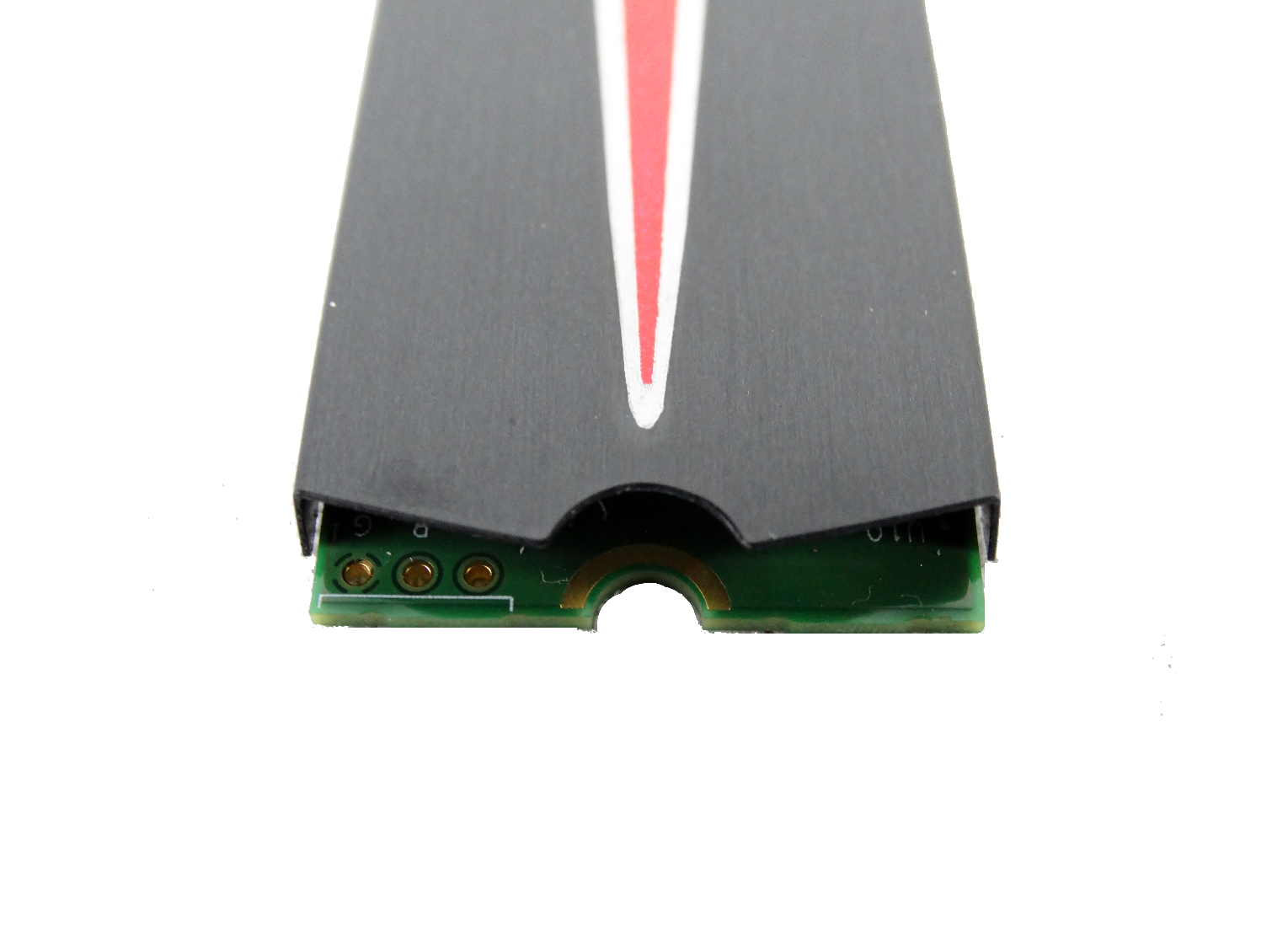
The Plextor M8Pe(G) ships with the thin aluminum heatsink installed from the factory. The M8PeGN ships without a heatsink. It surprised me how well the small cooler performed in our testing. I think you will also be surprised. The dense thermal transfer material may account for the majority of the cooling advantages. Either way, it is always beneficial to ensure proper airflow in your computer case. Many of the modern components are very small, can generate a lot of heat, and run better with active cooling.
MORE: Best SSDs
MORE: Latest Storage News
MORE: Storage in the Forums

Chris Ramseyer was a senior contributing editor for Tom's Hardware. He tested and reviewed consumer storage.


